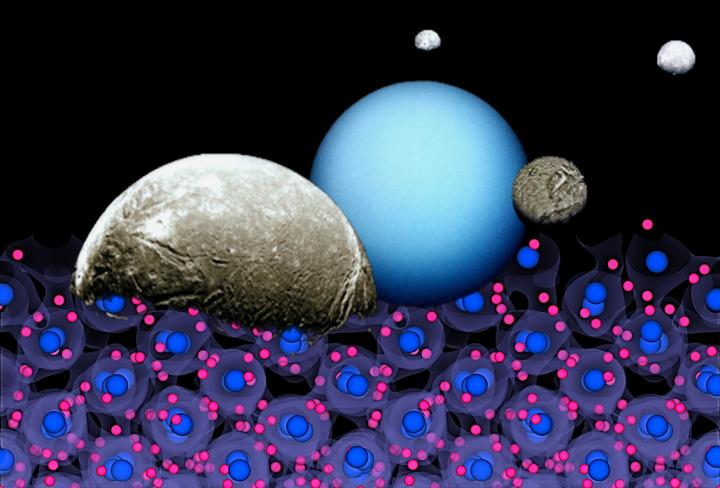Scientists probe the weird, alien water inside of Uranus and Neptune

Researchers are investigating an alien version of water inside the strange, icy interiors of Uranus and Neptune.
In a new study, scientists have devised a theoretical computer model and used it to peer inside the ice giants Uranus and Neptune. With this tool, the team studied the thermal and electrical conductivity of the unusual water inside of these planets. In simulating these physical processes on the teeny-tiny atomic scale, the researchers hope that this new model will reveal information about the icy bodies' internal structure, magnetic fields, how they evolved and exactly how old they are.
In studying Uranus and Neptune with this model, the researchers, who stem from the International School for Advanced Studies (SISSA) in Trieste, Italy and the University of California at Los Angeles, estimated that the two planets are likely primarily composed of water in some form and Uranus might even have a frozen core, according to a SISSA statement.
Related: What is Uranus made of?
"Hydrogen and oxygen are the most common elements in the Universe, together with helium. It is easy to deduce that water is one of the major constituents of many celestial bodies," the researchers said in the same statement.
The team looked at three different phases of water that could exist in these planets interiors: ice, liquid and superionic (superionic water exists at extremely high temperatures and pressures.) But, as the researchers explained in the statement, water on (and inside of) an alien planet is far different from water on Earth.
"In such exotic physical conditions, we cannot think of ice as we are used to," SISSA professors and study co-authors Federico Grasselli and Stefano Baroni said in the statement. "Even water is actually different, denser, with several molecules dissociated into positive and negative ions, thus carrying an electrical charge. Superionic water lies somewhere between the liquid and solid phases."
Get the Space.com Newsletter
Breaking space news, the latest updates on rocket launches, skywatching events and more!
So what did they find about the water inside of these ice giants? The researchers hypothesize, they explained in the statement, that Uranus might actually have a frozen core. This would explain why the planet isn't very luminous, as a frozen core would mean that very little heat would move towards the planet's surface, according to the statement.
The scientists also found that superionic water in Uranus and Neptune is more electrically conductive than water on Earth, and they think that superionic water could compose a large portion of the dense inner layers of these gas giants. These results further our understanding of exactly how the two bodies are composed and how they came to be, the study suggests.
As the two scientists said in the statement, "Thermal and electrical conduction dictates a "planet's history, how and when it was formed, how it cooled down. It is therefore crucial to analyze them with the appropriate tools, like the one we have developed."
This work was published July 17 in the journal Nature Communications.
Email Chelsea Gohd at cgohd@space.com or follow her on Twitter @chelsea_gohd. Follow us on Twitter @Spacedotcom and on Facebook.
Join our Space Forums to keep talking space on the latest missions, night sky and more! And if you have a news tip, correction or comment, let us know at: community@space.com.

Chelsea “Foxanne” Gohd joined Space.com in 2018 and is now a Senior Writer, writing about everything from climate change to planetary science and human spaceflight in both articles and on-camera in videos. With a degree in Public Health and biological sciences, Chelsea has written and worked for institutions including the American Museum of Natural History, Scientific American, Discover Magazine Blog, Astronomy Magazine and Live Science. When not writing, editing or filming something space-y, Chelsea "Foxanne" Gohd is writing music and performing as Foxanne, even launching a song to space in 2021 with Inspiration4. You can follow her on Twitter @chelsea_gohd and @foxannemusic.
-
Mergatroid It's not every day we see an article about scientists probing Uranus.Reply
And they say it might have a frozen core? No wonder I often feel so chilly..... -
rod FYI, the paper cited shows the calculations used and the equation of state for the *alien water* :) 240 Gpa = 3.4809E+07, that is some pressure :) "The ice giants, Uranus and Neptune, are thought to be composed primarily of H2O4: throughout most of their interior, the large pressure and temperature (e.g., 240 GPa and 5000 K at half the radius of Uranus) favor a super-ionic (SI) phase, where oxygen ions are arranged in a crystalline lattice and protons diffuse freely like in a fluid5,6.", https://www.nature.com/articles/s41467-020-17275-5 As the paper stated "More generally, a detailed knowledge of the transport properties of different phases of H2O occurring at high-pT conditions is key to any quantitative evolutionary model of water-rich celestial bodies. In spite of the steady progress in diamond-anvil-cell and shock-wave technologies, the experimental investigation of transport properties of materials at planetary conditions is still challenging."Reply
Yep, the math and EOS is indeed challenging. I like the geeky stuff :) -
Postman1 Reply
I'm just fine never to know how it got there.....Hughjer said:Well if there is alien water inside of Uranus, I would like to know how it got there. -
COLGeek A couple of folks here are being a bit too literal...I see what you did there.:rolleyes:Reply









